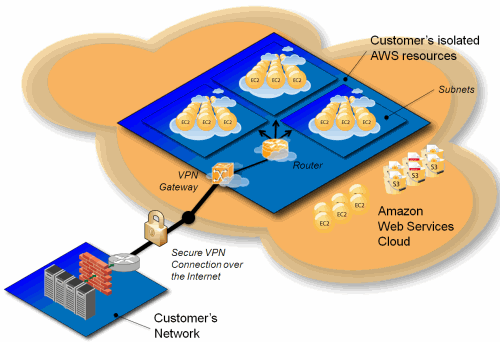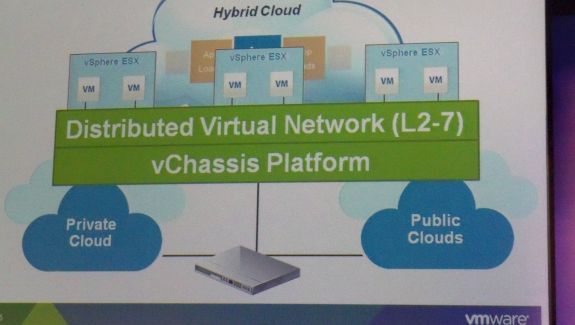Hybrid Clouds: are we there yet?
by Johan De Gelas on October 18, 2010 2:05 PM EST- Posted in
- IT Computing
Building a bridge between two datacenters is pretty easy and mature. In fact many of you do this on a daily basis: you make a VPN connection between your own network and a remote network. Site to site VPNs have been available for quite some time now. And that is exactly what Amazon offers with their VPC product.

Howie Xu, R&D Director from VMware, presented VMware’s vision concerning the future of networking. VMware virtual switch was the first step. The vswitch offered portgroups which allowed you to separate storage, console and VM networking from each other. A vswitch was always limited to one server, one host.
In vSphere 4.0, the distributed vSwitch was born. In 4.1 with VLANs and traffic shaping was introduced. Distributed switches can span several servers, making it easier to configure networking for a complete cluster instead of configuring vSwitches on different hosts.
The next step would be to creat a Distributed Virtual Network, a virtual networking chassis. This vChassis would be able to create a distributed network from layer 2 to 7 accross two or more datacenters.
Unfortunately, the presentation did not give any insight on how this will be accomplished.











26 Comments
View All Comments
pjkenned - Monday, October 18, 2010 - link
Stuff is still new but is pretty wow in real life. Clients are based on Android and make that Mitel stuff look like 1990's tech.Gilbert Osmond - Monday, October 18, 2010 - link
I enjoy and benefit from Anandtech's articles on the larger-picture network & structural aspects of contemporary IT services. I wonder if, as Anandtech's readership age-cohort "grows up" and matures into higher management- and executive-level IT job positions, the demand for articles with this kind of content & focus will increase. I hope so.AstroGuardian - Tuesday, October 19, 2010 - link
FYI it does to some extent... :) "You can't stop the progress" right?JohanAnandtech - Tuesday, October 19, 2010 - link
While we get less comments on our enterprise articles, they do pretty well. For example the Server Clash article was in the same league as the latest Geforce and SSD reviews. We can't beat Sandy Bridge previews of course :-).And while in the beginning of the IT section we got a lot of AMD vs Intel flames, nowadays we get some very solid discussions, right on target.
HMTK - Tuesday, October 19, 2010 - link
Like back then at Ace's? ;-)rbarone69 - Tuesday, October 19, 2010 - link
You couldn't have said it better! As an IT Director find information that this site gives invaluable to my decision making. Articles like this give me a jumping off point to thinking outside the box or adding tech I never heard of to our existing infrastructure.What's amazing is that we put very little in new equipment and are able to do what cost millions just 10 years ago. We can now offer 99.999% normal availability with only a maximum of 30minutes of downtime during a full datacenter switch from Toronto to Chicago!
The combination of fast multi core processors, virtualization tech and cheaper bandwidth have made this type of service availalbe to companies of all sizes. Very exciting times!
FunBunny2 - Monday, October 18, 2010 - link
The problem with Clouding is that systems are built to the lowest common denominator (which is to say, Cheap) hardware. The cutting edge is with SSD storage, and it's not likely that public Clouds are going to spend the money.Mattbreitbach - Monday, October 18, 2010 - link
I actually see this going forward. I would put money on public cloud hosts offering different storage options, and pricing brackets to match. I also do not believe that many of the emerging cloud environments are being build with the cheapest hardware available. I would be more inclined to think that some of the providers out there are going for high-end clients who are willing to shell out the cash for performance.mlambert - Monday, October 18, 2010 - link
3PAR, HDS (VSP's) and soon EMC will all have some form of block/page/region level dynamic optimization for auto-tiering between SSD/FC-SAS/SATA. When the majority of your storage is 2TB SATA drives but you still have the hot 3-5% on SSD the costs really come down.HDS and 3PAR both do it very well right now... with HDS firmly in the lead come next April...
The problem I see is the 100-120km dark fiber sync limitation. Once someone figures out how to be sync with 20-40ms latency (or the internets somehow figure out how reduce latency) we will have some pretty cool "clouds".
rd_nest - Monday, October 18, 2010 - link
Not willing to start another vendor war here :)Wanted to make a minor correction - EMC already has dynamic sub-LUN block optimization..Also called FAST - fully automated storage teiring like you mentioned. This is in both CLARiiON and V-Max...the implementation is different, but works almost same.
Don't you feel 20-40ms is bit too much?? Most database applications/or any famous MS applications don't like this amount of latency. Though quite subjective, I tend to believe that 10-20ms is what most people want.
Well, I am sure if it is reduced to 10-20ms, people will start asking for 5ms :)